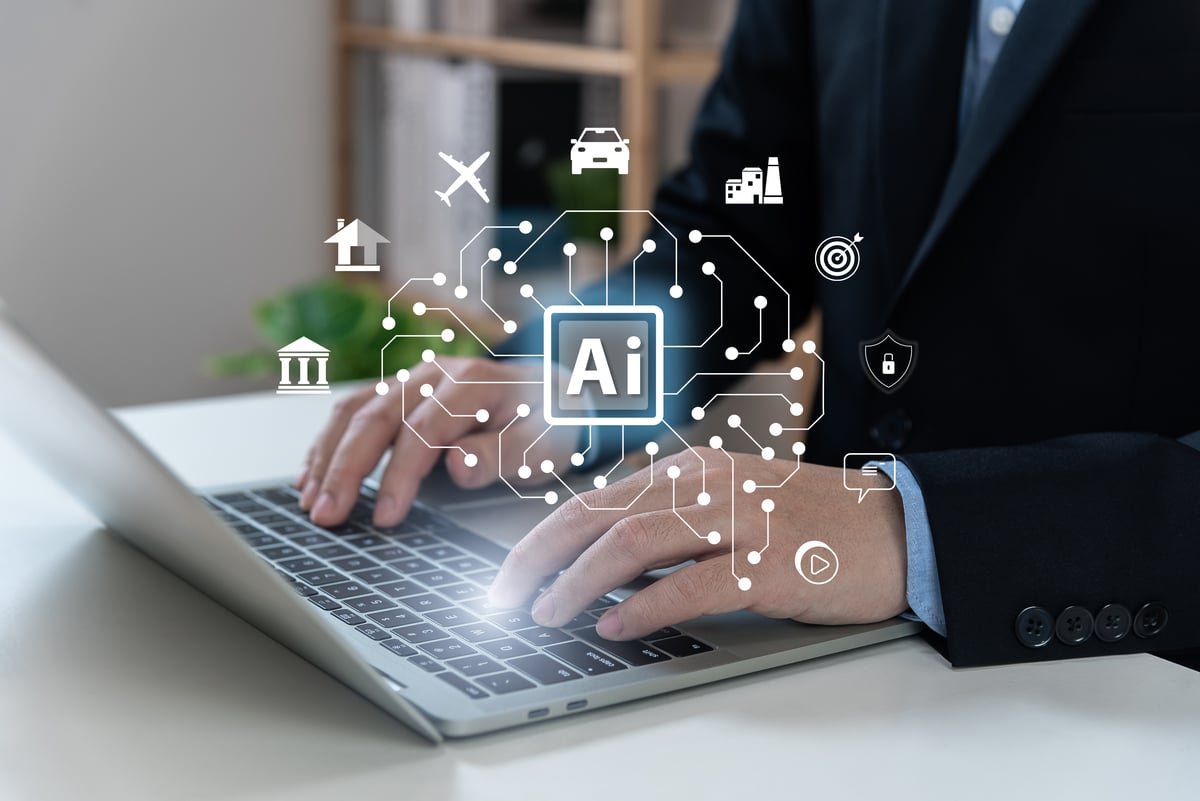AI Insights
This Artificial Intelligence Stock Has Beaten the Market in 9 of the Past 10 Years. And It’s On Track to Do It Again in 2025.

-
Broadcom stock has accumulated gains of more than 2,000% in the past 10 years.
-
Strong demand from tech hyperscalers highlights both a strength and vulnerability for the stock.
Investing in top growth stocks is a great way to achieve strong returns and potentially outperform the market as a whole. The S&P 500 is an index of the leading companies on the U.S. markets, and historically, it has risen by 10% per year, though that’s an average including up and down years. That return is not guaranteed, but at such a high rate, an investment would double after a little more than seven years.
One artificial intelligence (AI) stock that has routinely outperformed the broad index is Broadcom (NASDAQ: AVGO).
The semiconductor and infrastructure company has benefited from the growth in tech in recent years, and that has allowed it to outperform the market on a consistent basis. With strong gains once again so fare this year, is Broadcom still a great buy, or could it be due for a pullback?
Here’s a look at just how well Broadcom has performed over the previous 10 years, compared to the S&P 500.
|
Year |
S&P 500 Return |
AVGO Return |
|---|---|---|
|
2024 |
23.31% |
107.69% |
|
2023 |
24.23% |
99.64% |
|
2022 |
(19.44%) |
(15.97%) |
|
2021 |
26.89% |
51.97% |
|
2020 |
16.26% |
38.55% |
|
2019 |
28.88% |
24.28% |
|
2018 |
(6.24%) |
(1.02%) |
|
2017 |
19.42% |
45.33% |
|
2016 |
9.54% |
21.78% |
|
2015 |
(0.73%) |
44.30% |
Data source: YCharts.
What’s surprising is that the one year when the S&P 500 did better than Broadcom was 2019, when the index finished higher at nearly 29%, versus 24% gains for Broadcom.
The past doesn’t predict the future, but the tech stock’s terrific run can’t be ignored. In 10 years, shares of Broadcom have risen by more than 2,000%, while the S&P 500 has increased by around 200%.
As of the end of last week, Broadcom’s stock was up around 19% for the year, which was comfortably above the S&P 500’s returns of more than 6%. But with a valuation of around $1.3 trillion and Broadcom trading at 33 times its estimated future earnings (based on analyst estimates), it’s not a cheap stock to own.
The biggest risk is that the company relies heavily on demand from hyperscalers. These are big tech giants that have significant infrastructure needs related to tech and AI. If they scale back on their expenditures, that could significantly weigh on Broadcom’s results. The company estimates that its top five customers account for around 40% of its revenue.
AI Insights
How AI is eroding human memory and critical thinking
AI Insights
The human thinking behind artificial intelligence

Artificial intelligence is built on the thinking of intelligent humans, including data labellers who are paid as little as US$1.32 per hour. Zena Assaad, an expert in human-machine relationships, examines the price we’re willing to pay for this technology. This article was originally published in the Cosmos Print Magazine in December 2024.
From Blade Runner to The Matrix, science fiction depicts artificial intelligence as a mirror of human intelligence. It’s portrayed as holding a capacity to evolve and advance with a mind of its own. The reality is very different.
The original conceptions of AI, which hailed from the earliest days of computer science, defined it as the replication of human intelligence in machines. This definition invites debate on the semantics of the notion of intelligence.
Can human intelligence be replicated?
The idea of intelligence is not contained within one neat definition. Some view intelligence as an ability to remember information, others see it as good decision making, and some see it in the nuances of emotions and our treatment of others.
As such, human intelligence is an open and subjective concept. Replicating this amorphous notion in a machine is very difficult.
Software is the foundation of AI, and software is binary in its construct; something made of two things or parts. In software, numbers and values are expressed as 1 or 0, true or false. This dichotomous design does not reflect the many shades of grey of human thinking and decision making.
Not everything is simply yes or no. Part of that nuance comes from intent and reasoning, which are distinctly human qualities.
To have intent is to pursue something with an end or purpose in mind. AI systems can be thought to have goals, in the form of functions within the software, but this is not the same as intent.
The main difference is goals are specific and measurable objectives whereas intentions are the underlying purpose and motivation behind those actions.
You might define the goals as ‘what’, and intent as ‘why’.
To have reasoning is to consider something with logic and sensibility, drawing conclusions from old and new information and experiences. It is based on understanding rather than pattern recognition. AI does not have the capacity for intent and reasoning and this challenges the feasibility of replicating human intelligence in a machine.
There is a cornucopia of principles and frameworks that attempts to address how we design and develop ethical machines. But if AI is not truly a replication of human intelligence, how can we hold these machines to human ethical standards?
Can machines be ethical?
Ethics is a study of morality: right and wrong, good and bad. Imparting ethics on a machine, which is distinctly not human, seems redundant. How can we expect a binary construct, which cannot reason, to behave ethically?
Similar to the semantic debate around intelligence, defining ethics is its own Pandora’s box. Ethics is amorphous, changing across time and place. What is ethical to one person may not be to another. What was ethical 5 years ago may not be considered appropriate today.
These changes are based on many things; culture, religion, economic climates, social demographics, and more. The idea of machines embodying these very human notions is improbable, and so it follows that machines cannot be held to ethical standards. However, what can and should be held to ethical standards are the people who make decisions for AI.
Contrary to popular belief, technology of any form does not develop of its own accord. The reality is their evolution has been puppeteered by humans. Human beings are the ones designing, developing, manufacturing, deploying and using these systems.
If an AI system produces an incorrect or inappropriate output, it is because of a flaw in the design, not because the machine is unethical.
The concept of ethics is fundamentally human. To apply this term to AI, or any other form of technology, anthropomorphises these systems. Attributing human characteristics and behaviours to a piece of technology creates misleading interpretations of what that technology is and is not capable of.
Decades long messaging about synthetic humans and killer robots have shaped how we conceptualise the advancement of technology, in particular, technology which claims to replicate human intelligence.
AI applications have scaled exponentially in recent years, with many AI tools being made freely available to the general public. But freely accessible AI tools come at a cost. In this case, the cost is ironically in the value of human intelligence.
The hidden labour behind AI
At a basic level, artificial intelligence works by finding patterns in data, which involves more human labour than you might think.
ChatGPT is one example of AI, referred to as a large language model (LLM). ChatGPT is trained on carefully labelled data which adds context, in the form of annotations and categories, to what is otherwise a lot of noise.
Using labelled data to train an AI model is referred to as supervised learning. Labelling an apple as “apple”, a spoon as “spoon”, a dog as “dog”, helps to contextualise these pieces of data into useful information.
When you enter a prompt into ChatGPT, it scours the data it has been trained on to find patterns matching those within your prompt. The more detailed the data labels, the more accurate the matches. Labels such as “pet” and “animal” alongside the label “dog” provide more detail, creating more opportunities for patterns to be exposed.
Data is made up of an amalgam of content (images, words, numbers, etc.) and it requires this context to become useful information that can be interpreted and used.
As the AI industry continues to grow, there is a greater demand for developing more accurate products. One of the main ways for achieving this is through more detailed and granular labels on training data.
Data labelling is a time consuming and labour intensive process. In absence of this work, data is not usable or understandable by an AI model that operates through supervised learning.
Despite the task being essential to the development of AI models and tools, the work of data labellers often goes entirely unnoticed and unrecognised.
Data labelling is done by human experts and these people are most commonly from the Global South – Kenya, India and the Philippines. This is because data labelling is labour intensive work and labour is cheaper in the Global South.
Data labellers are forced to work under stressful conditions, reviewing content depicting violence, self-harm, murder, rape, necrophilia, child abuse, bestiality and incest.
Data labellers are pressured to meet high demands within short timeframes. For this, they earn as little as US$1.32 per hour, according to TIME magazine’s 2023 reporting, based on an OpenAI contract with data labelling company Sama.
Countries such as Kenya, India and the Philippines incur less legal and regulatory oversight of worker rights and working conditions.
Similar to the fast fashion industry, cheap labour enables cheaply accessible products, or in the case of AI, it’s often a free product.
AI tools are commonly free or cheap to access and use because costs are being cut around the hidden labour that most people are unaware of.
When thinking about the ethics of AI, cracks in the supply chain of development rarely come to the surface of these discussions. People are more focused on the machine itself, rather than how it was created. How a product is developed, be it an item of clothing, a TV, furniture or an AI-enabled capability, has societal and ethical impacts that are far reaching.
A numbers game
In today’s digital world, organisational incentives have shifted beyond revenue and now include metrics around the number of users.
Releasing free tools for the public to use exponentially scales the number of users and opens pathways for alternate revenue streams.
That means we now have a greater level of access to technology tools at a fraction of the cost, or even at no monetary cost at all. This is a recent and rapid change in the way technology reaches consumers.
In 2011, 35% of Americans owned a mobile phone. By 2024 this statistic increased to a whopping 97%. In 1973, a new TV retailed for $379.95 USD, equivalent to $2,694.32 USD today. Today, a new TV can be purchased for much less than that.
Increased manufacturing has historically been accompanied by cost cutting in both labour and quality. We accept poorer quality products because our expectations around consumption have changed. Instead of buying things to last, we now buy things with the expectation of replacing them.
The fast fashion industry is an example of hidden labour and its ease of acceptance in consumers. Between 1970 and 2020, the average British household decreased their annual spending on clothing despite the average consumer buying 60% more pieces of clothing.
The allure of cheap or free products seems to dispel ethical concerns around labour conditions. Similarly, the allure of intelligent machines has created a facade around how these tools are actually developed.
Achieving ethical AI
Artificial intelligence technology cannot embody ethics; however, the manner in which AI is designed, developed and deployed can.
In 2021, UNESCO released a set of recommendations on the ethics of AI, which focus on the impacts of the implementation and use of AI. The recommendations do not address the hidden labour behind the development of AI.
Misinterpretations of AI, particularly those which encourage the idea of AI developing with a mind of its own, isolate the technology from the people designing, building and deploying that technology. These are the people making decisions around what labour conditions are and are not acceptable within their supply chain, what remuneration is and isn’t appropriate for the skills and expertise required for data labelling.
If we want to achieve ethical AI, we need to embed ethical decision making across the AI supply chain; from the data labellers who carefully and laboriously annotate and categorise an abundance of data through to the consumers who don’t want to pay for a service they have been accustomed to thinking should be free.
Everything comes at a cost, and ethics is about what costs we are and are not willing to pay.
AI Insights
Apple sued by authors over use of books in AI training

Tim Cook, chief executive officer of Apple Inc., during the 60th presidential inauguration in the rotunda of the US Capitol in Washington, DC, US, on Monday, Jan. 20, 2025.
Bloomberg | Getty Images
Technology giant Apple was accused by authors in a lawsuit on Friday of illegally using their copyrighted books to help train its artificial intelligence systems, part of an expanding legal fight over protections for intellectual property in the AI era.
The proposed class action filed in the federal court in Northern California, said Apple copied protected works without consent and without credit or compensation.
“Apple has not attempted to pay these authors for their contributions to this potentially lucrative venture,” according to the lawsuit, filed by authors Grady Hendrix and Jennifer Roberson.
Apple and lawyers for the plaintiffs did not immediately respond to requests for comment on Friday.
The lawsuit is the latest in a wave of cases from authors, news outlets and others accusing major technology companies of violating legal protections for their works.
Artificial intelligence startup Anthropic on Friday disclosed in a court filing in California that it agreed to pay $1.5 billion to settle a class action from a group of authors who accused the company of using their books to train its AI chatbot Claude without permission.
Anthropic did not admit any liability in the accord, which lawyers for the plaintiffs called the largest publicly reported copyright recovery in history.
In June, Microsoft was hit with a lawsuit by a group of authors who claimed the company used their books without permission to train its Megatron artificial intelligence model. Meta Platforms and Microsoft-backed OpenAI also have faced claims over the alleged misuse of copyrighted material in AI training.
The lawsuit against Apple accused the company of using a known body of pirated books to train its “OpenELM” large language models.
Hendrix, who lives in New York, and Roberson in Arizona, said their works were part of the pirated dataset, according to the lawsuit.
-

 Business1 week ago
Business1 week agoThe Guardian view on Trump and the Fed: independence is no substitute for accountability | Editorial
-
Tools & Platforms4 weeks ago
Building Trust in Military AI Starts with Opening the Black Box – War on the Rocks
-

 Ethics & Policy1 month ago
Ethics & Policy1 month agoSDAIA Supports Saudi Arabia’s Leadership in Shaping Global AI Ethics, Policy, and Research – وكالة الأنباء السعودية
-

 Events & Conferences4 months ago
Events & Conferences4 months agoJourney to 1000 models: Scaling Instagram’s recommendation system
-

 Jobs & Careers2 months ago
Jobs & Careers2 months agoMumbai-based Perplexity Alternative Has 60k+ Users Without Funding
-

 Education2 months ago
Education2 months agoVEX Robotics launches AI-powered classroom robotics system
-

 Funding & Business2 months ago
Funding & Business2 months agoKayak and Expedia race to build AI travel agents that turn social posts into itineraries
-

 Podcasts & Talks2 months ago
Podcasts & Talks2 months agoHappy 4th of July! 🎆 Made with Veo 3 in Gemini
-

 Education2 months ago
Education2 months agoMacron says UK and France have duty to tackle illegal migration ‘with humanity, solidarity and firmness’ – UK politics live | Politics
-

 Podcasts & Talks2 months ago
Podcasts & Talks2 months agoOpenAI 🤝 @teamganassi




